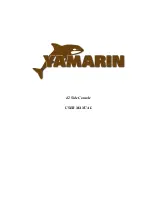
90
WARNING
Leaving a Mooring
Start the engine or engines and let them warm up
for several minutes before releasing the mooring
line. The boat will already be headed into the
wind, so move it forward enough to loosen the
line and untie it. Back the boat away from the
mooring until you can see the buoy. Move the
boat slowly away from the mooring.
Anchoring
Make sure the
bitter end of
the anchor line
is attached to
b o a t b e f o r e
dropping the
anchor. Bring
the bow into the
wind or current and put the engine or engines in
neutral. When the vessel comes to a stop, lower
the anchor over the bow. Pay out anchor line so
that it is at least 5 to 7 times the depth of the
water and secure the line to a cleat. Use caution
to avoid getting your feet or hands tangled in
the line. Additional scope of 10 times the depth
may be required for storm conditions. Check
landmarks on shore or your GPS position to make
sure the anchor is not dragging. If it is dragging,
you will have to start all over. It is prudent to use
two anchors if your are anchoring overnight or in
rough weather.
Releasing the Anchor
Release the anchor by driving the boat slowly to
the point where the anchor line becomes verti-
cal. It should release when you pass that point.
If the anchor doesn’t release right away, stop the
boat directly above the anchor and tie the line to
the cleat as tight as possible. The up and down
movement of the boat will usually loosen the an-
chor within a minute. Make sure you secure the
anchor and properly stow the line before operat-
ing the boat.
NEVER ANCHOR THE BOAT BY THE STERN. THE STERN
OF THE BOAT IS VULNERABLE TO SWAMPING FROM WAVE
ACTION AND WIND AND CURRENT WILL PUT MORE STRESS
ON THE ANCHOR WHEN IT IS ATTACHED TO THE STERN. ONLY
ANCHOR THE BOAT BY THE BOW
12.6 Controls, Steering, or
Propulsion System Failure
If the propulsion, control or steering system fails
while you are operating the boat, bring the throt-
tles to idle and shift to neutral. Decide whether
you need to put out the anchor to prevent the boat
from drifting or to hold the bow into the seas. In-
vestigate and correct the problem if you can. Turn
the engine off before opening the engine cowling
to make repairs. If you are unable to correct the
problem, call for help.
If only one engine has failed on a twin engine
boat, you can usually run home on the other
engine. Be careful not to apply too much power
to the engine that is running. When only one
engine is used to power a twin engine boat, that
engine is over propped and can be overloaded if
too much throttle is applied. You should contact
your dealer or the engine manufacturer for the
maximum power settings when running without
one engine.
12.7 Collision
If your boat is involved in a collision with another
boat, dock, piling or a sandbar, your first priority is
to check your passengers for injuries and admin-
ister first aid if necessary. Once your passenger’s
situations are stabilized, thoroughly inspect the
boat for damage. Check below decks for leaks and
the control systems for proper operation. Plug all
leaks or make the necessary repairs to the control
systems before proceeding slowly and carefully to
port. Request assistance if necessary. Haul the
boat and make a thorough inspection of the hull
and running gear for damage.
12.8 Grounding, Towing and
Rendering Assistance
The law requires the owner or operator of a vessel
to render assistance to any individual or vessel in
distress, as long as his vessel is not endangered
in the process.
If the boat should become disabled, or if another
craft that is disabled requires assistance, great
care must be taken. The stress applied to a boat
during towing may become excessive. Excessive
stress can damage the structure of the boat and
create a safety hazard for those aboard.
Summary of Contents for 245 Abaco
Page 1: ...Owner s Manual Scout Boats Inc 2531 Hwy 78 West Summerville SC 29483 245 Abaco ...
Page 2: ...2 THIS PAGE WAS LEFT BLANK INTENTIONALLY Print Date 7 10 2010 ...
Page 4: ...4 THIS PAGE WAS LEFT BLANK INTENTIONALLY SAFETY INFORMATION ...
Page 8: ...8 THIS PAGE WAS LEFT BLANK INTENTIONALLY ...
Page 12: ...12 THIS PAGE WAS LEFT BLANK INTENTIONALLY ...
Page 18: ...18 Appendix E FLOAT PLAN 127 Appendix F TROUBLESHOOTING GUIDE 129 TABLE OF CONTENTS ...
Page 24: ...24 THIS PAGE WAS LEFT BLANK INTENTIONALLY ...
Page 32: ...32 THIS PAGE WAS LEFT BLANK INTENTIONALLY ...
Page 48: ...48 THIS PAGE WAS LEFT BLANK INTENTIONALLY ...
Page 52: ...52 THIS PAGE WAS LEFT BLANK INTENTIONALLY ...
Page 56: ...56 THIS PAGE WAS LEFT BLANK INTENTIONALLY ...
Page 60: ...60 THIS PAGE WAS LEFT BLANK INTENTIONALLY ...
Page 85: ...85 ...
Page 102: ...102 THIS PAGE WAS LEFT BLANK INTENTIONALLY ...
Page 108: ...108 THIS PAGE WAS LEFT BLANK INTENTIONALLY ...
Page 109: ...109 Electrical System SCHEMATICS Appendix A ...
Page 110: ...110 THIS PAGE WAS LEFT BLANK INTENTIONALLY ...
Page 116: ...116 ...
Page 118: ...118 MAINTENANCE LOG Hours Date Dealer Service Repairs ...
Page 119: ...119 MAINTENANCE LOG Hours Date Dealer Service Repairs ...
Page 120: ...120 MAINTENANCE LOG Hours Date Dealer Service Repairs ...
Page 121: ...121 MAINTENANCE LOG Hours Date Dealer Service Repairs ...
Page 122: ...122 MAINTENANCE LOG Hours Date Dealer Service Repairs ...
Page 123: ...123 Appendix D BOATING ACCIDENT REPORT ...
Page 124: ...124 ...
Page 125: ...125 ...
Page 126: ...126 THIS PAGE WAS LEFT BLANK INTENTIONALLY ...
Page 128: ...128 THIS PAGE WAS LEFT BLANK INTENTIONALLY ...
Page 134: ......
Page 135: ......
















































